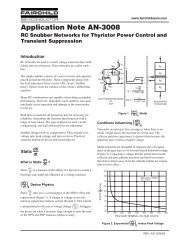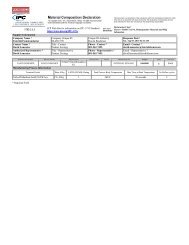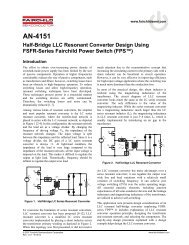AN-9732 - Fairchild Semiconductor
AN-9732 - Fairchild Semiconductor
AN-9732 - Fairchild Semiconductor
You also want an ePaper? Increase the reach of your titles
YUMPU automatically turns print PDFs into web optimized ePapers that Google loves.
<strong>AN</strong>-<strong>9732</strong> APPLICATION NOTE<br />
MOSFET; and<br />
CPAR is the parasitic capacitance shown at drain pin.<br />
Because the COSS is a function of the drain and source<br />
voltage, it is necessary to refer to graph data showing the<br />
relationship between COSS and voltage.<br />
Estimate the total power dissipation of MOSFET as the sum<br />
of three losses:<br />
PQ Q,<br />
CON Q,<br />
SWOFF Q,<br />
DISCHG<br />
P P P [ W ]<br />
(23)<br />
Diode voltage stress is the same as the output capacitor<br />
stress calculated in Equation (17).<br />
The average diode current and power loss are obtained as:<br />
I<br />
DOUT,<br />
AVE<br />
IOUT<br />
[ A]<br />
(24)<br />
<br />
PDOUT DROP,<br />
DOUT DOUT,<br />
AVE<br />
V I<br />
[ W ]<br />
(25)<br />
where VDROP,DOUT is the forward voltage drop of diode.<br />
(Design Example) Internal reference at the feedback pin<br />
is 2.5V and maximum tolerance of OVP trigger voltage is<br />
2.730V. If <strong>Fairchild</strong>’s FDP22N50N MOSFET and<br />
FFPF08H60S diode are selected, VD,FOR is 2.1V at 8A,<br />
25 o C, maximum RDS,ON is 0.185 at drain current is 11A,<br />
and maximum COSS is 50pF at drain-source voltage is<br />
480V.<br />
VOVP,<br />
MAX<br />
ST,<br />
Q VOUT<br />
V<br />
VREF<br />
2.<br />
73<br />
400<br />
2.<br />
1 438.<br />
9 [ V ]<br />
2.<br />
50<br />
V DROP,<br />
DIODE<br />
<br />
PQ, CON <br />
<br />
IL,<br />
PK<br />
<br />
<br />
<br />
<br />
2<br />
<br />
1 4 2 VLINE<br />
<br />
<br />
<br />
6 9<br />
VOUT<br />
<br />
<br />
<br />
DS,<br />
ON<br />
<br />
<br />
<br />
6.<br />
984<br />
<br />
<br />
<br />
<br />
2<br />
<br />
1 4 2 90<br />
<br />
<br />
<br />
6 9<br />
400<br />
<br />
<br />
<br />
R 0. 1853<br />
3.<br />
29[<br />
W]<br />
1<br />
PQ , SWOFF VOUT<br />
I L tOFF<br />
fSW<br />
2<br />
1<br />
400<br />
2.<br />
469<br />
50ns<br />
(<br />
50k<br />
/ 0.<br />
8)<br />
1.<br />
54[<br />
W ]<br />
2<br />
1<br />
2<br />
PQ, DISCHG<br />
COSS<br />
CEXT<br />
CPARVOUT<br />
fSW<br />
2<br />
1<br />
2<br />
50p<br />
400 (<br />
50k<br />
/ 0.<br />
8)<br />
0.<br />
25[<br />
W]<br />
2<br />
Diode average current and forward-voltage drop loss as:<br />
I<br />
DOUT,<br />
AVE<br />
IOUT<br />
0.<br />
5<br />
<br />
0.<br />
9<br />
0.<br />
56[<br />
A]<br />
PDOUT, LOSS VDOUT,<br />
FOR IDOUT,<br />
AVE 2.<br />
1<br />
0.<br />
56 1.<br />
46[<br />
W ]<br />
[STEP-8] Determine Current-Sense Resistor<br />
It is typical to set pulse-by-pulse current limit level a little<br />
higher than the maximum inductor current calculated by<br />
Equation (3). For 10% margin, the current-sensing resistor is<br />
selected as:<br />
VCS,<br />
LIM<br />
[ ]<br />
(26)<br />
I 1.<br />
1<br />
© 2011 <strong>Fairchild</strong> <strong>Semiconductor</strong> Corporation www.fairchildsemi.com<br />
Rev. 1.0.0 • 3/23/11 12<br />
R<br />
CS<br />
L,<br />
PK<br />
Once resistance is calculated, its power loss at low line is<br />
calculated as:<br />
2<br />
PRCS Q,<br />
RMS CS<br />
I R<br />
[ W ]<br />
(27)<br />
Power rating of the sensing resistor is recommended a twice<br />
the power rating calculated in Equation (27).<br />
(Design Example) Maximum inductor current is 4.889A<br />
and sensing resistor is calculated as:<br />
R<br />
CS<br />
V<br />
<br />
I<br />
CS,<br />
LIM<br />
pk<br />
ind <br />
1.<br />
1<br />
<br />
6<br />
0.<br />
8<br />
. 984<br />
0.<br />
104[<br />
]<br />
1.<br />
1<br />
Choosing 0.1 as RCS, power loss is calculated as:<br />
P<br />
RCS,<br />
LOSS<br />
I<br />
2<br />
Q,<br />
RMS<br />
R<br />
CS<br />
2<br />
2.<br />
436 0.<br />
1 0.<br />
59[<br />
W]<br />
Recommended power rating of sensing resistor is 1.19W.







